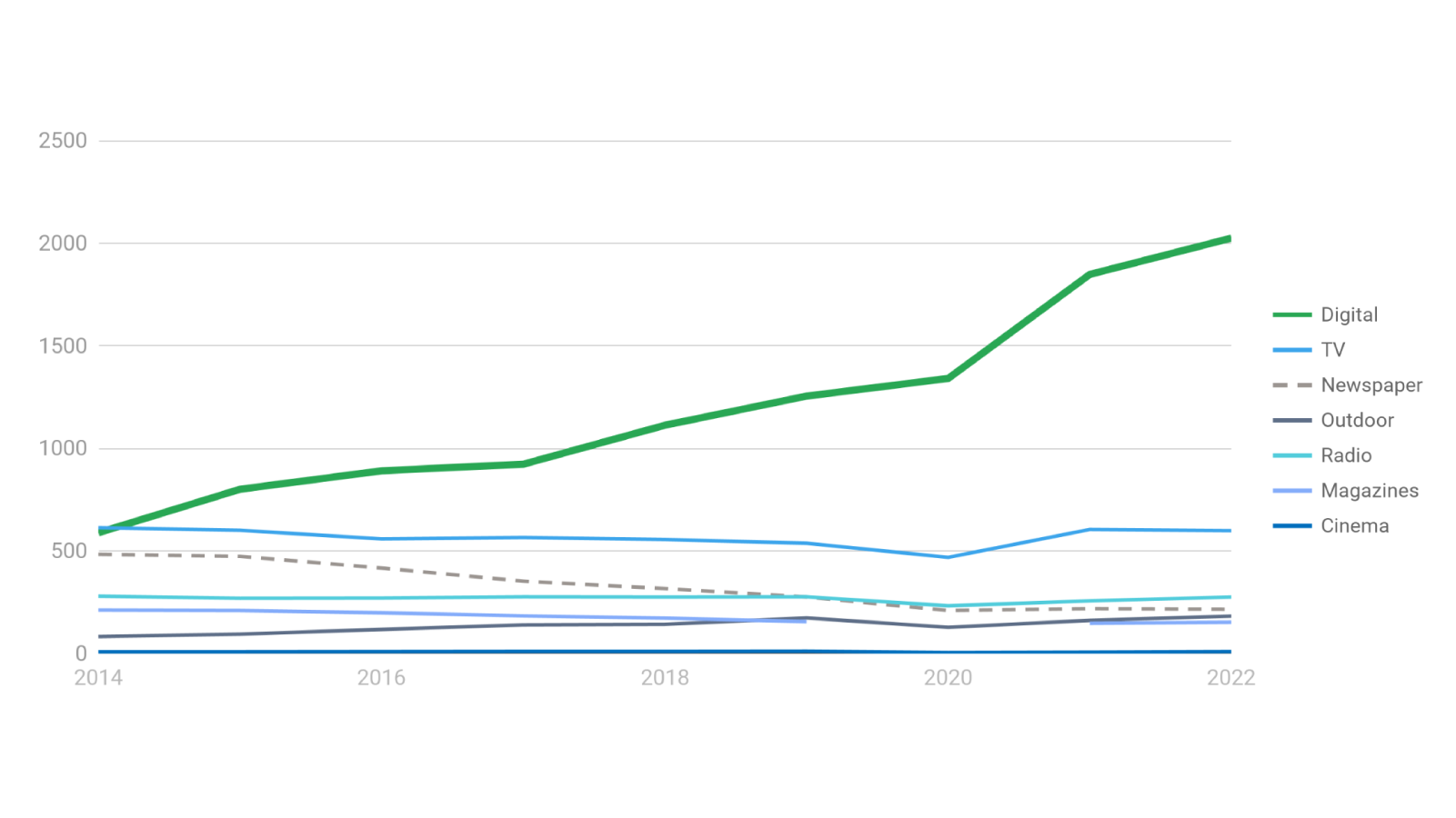Feature article
The digital takeover:
Print media in decline as audiences head online
Over the past decade, the media landscape in Aotearoa has undergone a dramatic transformation, largely driven by a change in consumer behaviour. Gone are the days when Kiwi would peruse property listings in newspapers or magazines at their local coffee shops. Now, they prefer to view and compare properties online - on a device that can fit in their pocket. In fact, online property portals have emerged as the first choice for consumers searching for a new property.1
With the average Kiwi spending around eight hours a day browsing the internet, it’s no surprise that print publications are being hit hardest.2
The changing media landscape
The print advertising industry has been experiencing a steady decline for several years, with an average year-on-year decrease in ad spend of 10.2% as reported by the Advertising Standards Authority in their yearly advertising turnover reports. The pandemic fast-tracked this trend, resulting in the sharpest drop in spending in 2020-2021. Conversely, the pace of transition to online has accelerated and shows no signs of slowing down - with a 44% growth reported in the last five years.3
New Zealand advertising industry spend 2014 - 2022 ($ millions per calendar year)
The future of print in Aotearoa
When examining the current state of print publications in Aotearoa, ibisworld.com states that "The newspaper publishing industry is in long-term decline", and when forecasting a five-year outlook, they predict a “continuation of decline over the next five years”.4
This is not just limited to advertising spend, but reach too, as audience numbers for newspaper and magazine advertising are expected to further decrease by 50% over the next five years.5
Given that advertising budgets are increasingly shifting towards digital channels and consumer reach is forecasted to decrease annually, the future for print publications appears grim.
Digital: An investment opportunity
Reaching a large audience is key to success, but being able to track and report on the efficacy of your reach is just as important. Traditional print media has always had a major drawback: the inability to accurately measure return on investment. In today's challenging economic climate, knowing your return is crucial when the wallet only stretches so far.
Digital advertising offers greater visibility and reporting capabilities, allowing businesses to measure their ROI - something you just can't get with traditional media. Vendor expectation is also shifting towards online, meaning marketing schedules should reflect those expectations. When asked in a recent consumer survey where vendor's would expect to spend more of their advertising budget, print or online, online was the vendor's #1 choice for where the majority of their budget should go.1
Influencing consumer decision making in the digital age
Kiwi are spending more time online than ever before, and are relying on digital sources of information when making purchase decisions. When buying or selling a property, it's no different.
As revealed in a recent consumer survey, an agent's online presence is the #1 reason vendors knew about salespeople in their area.1 In fact:
- 98% of vendors learned about local salespeople through their digital footprint, and;
- 86% discovered them through property portals.
The survey further highlights the significance of establishing a strong digital presence to connect with as many buyers as possible, given that 99% of property buyers turn to online channels when searching for property.
Understanding digital metrics: Page views vs. impressions
You’ll often hear us talking about 'page views', but what does that even mean? Put simply, a page view indicates intent. Listing page views are only counted when a person clicks on your listing and is taken through to your listing page.
You may come across other terms such as, "impressions" or “search views” which may sound impressive, but it falls short of providing any valuable insights. These terms indicate appearing within a search result - however, they don’t indicate any intent or action taken by the viewer such as clicking on your listing, as they may have scrolled past it with no engagement.
Trade Me Property snapshot
On Trade Me Property you can list once and reach two audiences, maximising not only your listing reach but brand exposure too.
- Trade Me Property - 3.4M monthly users (58.2M page views)6
- homes.co.nz - 1.01M monthly users (26.2M page views)6
On average, over 250,000 Kiwi visit Trade Me Property daily with:7
- 56,000 actively searching, ready to find a home, viewing 62 properties per week8
- 279,000 potential buyers and/or sellers browsing, viewing 7 properties per week8
It's just as important to reach those passive browsers as it is active as those 279,000 could turn active in two weeks, or two years - but they're on site, and they're looking - which is why it's important to get as many eyes on your listings as possible.
Maximise your opportunities online
As print loses its appeal, and consumers favour digital, it's essential for businesses to be strategic and establish a strong digital presence to connect with as many buyers and sellers as possible.
Want to know how we can help? We have the ultimate solution - Platinum Plus! Not only does Platinum Plus reach more active and passive buyers, but by using the power of Trade Me audience data we can retarget those that have already viewed your listing, along with targeting additional buyers through the use of powerful products.
Get in touch today to learn how Platinum Plus Partnership can help.
Substantiations
1Trade Me Property consumer survey, April 2023
2Global Web Index, New Zealand, 2022
3New Zealand Advertising Standards Authority, Turnover Reports, 2014 - 2022
4IBISWorld, Newspaper Publishing in New Zealand - Market Research Report, March 2022
5Statistica, March 2023
6Trade Me Google Analytics, 1 - 30 March 2023
7Trade Me Property site data, June 2022
8Trade Me Property site data, resi for sale & new homes, March 2022 - March 2023


